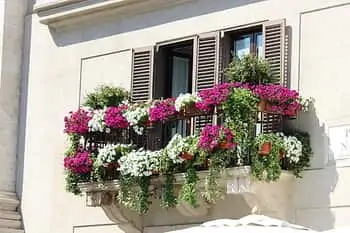So, you have just got your fresh and beautiful begonia. Or might be you already have one. But wondering how to take its proper care? You are in the right place.
How to take care of begonias? Begonias prefer bright indirect sunlight. So, keep them in a location where they can get sunlight for a few hours in the morning or evening. Avoid overwatering as it can cause root rot and use proper well-drained soil.
Further, I’m going to give you a complete guide on caring for begonias, their watering, sunlight, and all other requirements. So, make sure you read till the end. Let’s start!
Table of Contents
Watering
Begonias come in many varieties. Some varieties are popular among gardeners for their beautiful flowers. While there are some varieties that are popular for their leaves.
The color of the begonia leaves is also very beautiful and they are generally reddish, greenish. And begonias don’t grow in any specific symmetry.
Generally, the leaves and flowers grow in clusters.
The leaves of begonias are kind of fleshy. The leaves and stem begonias are juicy and feel like water accumulated within them.
So, with this kind of plant, the first thing you need to keep in mind is to water less but adequately.
You should water begonias only when a considerable part of the upper soil gets dry. As a general guideline, you let the top 1 inch of soil dry up completely and then only water it.
Do you get confused while watering your begonia? No problem! Here’s what you can do:
To check when to water just put your finger in the soil a little deep, about 1 inch, and see if the soil is sticking to your finger or not.
If the soil is sticking to your finger, then the soil still has moisture, so you have to wait for some time before you can water it. And if the soil doesn’t stick to your finger, then you can just water your plant. Easy, right?
Do keep in mind that if you over water begonia then it will start damaging your begonia.
What happens is, the roots of the plant need oxygen for their survival which means proper aeration is needed. But if you over water then the soil will become excessively and thus it will decrease the amount of aeration.
As a result of no oxygen supply to the soil (because of the lack of aeration in the soil) the roots will start getting affected.
As per smartgardenguide.com, consistently soggy soil can lead to root rot. So it is very essential to not overwater the begonia.
Sunlight

As per thespruce.com, many begonias don’t thrive in strong sunlight. So keep them in a location where they can get a few hours of the morning sunlight or a few hours of evening sunlight and shade during the strong sunlight.
Try to keep the begonia in a location where it can get the morning sunlight of generally no more than 3-4 hours.
Don’t have any location where your begonia can get morning sunlight? Don’t worry. You can keep your begonia in a location where it can have 3-4 hours of evening sunlight.
On the day when the sun is at its hottest, try to keep your begonias in a shade at that time.
You can also watch this video about the best way to grow & care for the begonia plant.
So either giving a few hours of sunlight in the morning or a few hours in the evening will be okay. Rest during the hot sun, try to keep it in shade.
Also, it is better to keep them in a shaded location that has some moisture. Begonias need high humidity to thrive.
You can keep your begonia in a shaded location in your garden where you already have some plants in a group. (When transpiration occurs in plants, they release water vapors which gradually get mixed in the surrounding air.)
So, you can keep your begonia in the atmosphere where there’s moisture in the air.
If you are thinking of keeping your begonia indoors, then you can also keep a saucer near your begonia plant so that the water evaporates and creates moisture in the surrounding.
However, don’t put the begonia pot on the saucer that has water because it will give rise to root rots.
Actually, you can keep your begonia plant kind of neglected. What I mean to say is, it just needs less but adequate watering and a few hours of morning sunlight.
But remember, if you keep your begonia in a place where it doesn’t get any sunlight, then it won’t grow properly. The stems of your begonia would start to become leggy.
So, begonias do require sunlight and they can’t grow in complete shade.
In short, the key thing is to give begonias just the required bright indirect sunlight that is essential for their growth.
Soil
Begonias need well-drained soil. I already discussed with you that begonia doesn’t need much water. And so the soil should be such that it doesn’t keep the water holding for a long time.
You can use less garden soil and more peat moss or coco peat.
Just as an example you can create the soil mix by following this ratio:
- Sand or husk 30%,
- Soil 30%,
- Compost 30%.
Another example of potting mix can be:
- Normal garden Soil 30%,
- Cocopeat 30%,
- Vermicompost 30%,
- Perlite 10%.
I’m giving these examples so that you can get some ideas. And if you are thinking of keeping begonia in the pot then make sure to check the drainage hole of the pot properly.
Fertilizer
You can add some quantity of compost such as cow dung powder. You can even use the NPK crystals in the pot.
If you can find any fertilizer specially made for begonias then you can use that as well. Look for package instructions and add fertilizers accordingly.
Generally, apply fertilizer when the plant is in its active growing phase.

Disease Protection
As per gardeningknowhow.com, it is extremely rare for begonias to develop any pest problem. However, they can still get affected by any fungal disease.
To avoid this issue you can use any fungicide. Since begonias are prone to powdery mildew, which is a common problem in high humidity areas, it is good to keep their leaves dry.
You can also spray neem oil. As per extension.unh.edu, neem oil can be used in managing some fungal issues. It actually prevents the germination and penetration of fungal spores into the leaf tissue.
You can find agricultural neem oil in the market. In that, you don’t have to mix anything. And if you keep plants then it is recommended to have the neem oil in your home.
You can just mix some amount of neem oil with the water and put that mix in your spraying bottle and start spraying on your begonias.
As a general rule, you can spray that mix after every twenty days as a preventive measure so that your begonia remains safe from any diseases.
Grooming
As a part of pruning, you can remove any blooms that have got faded or are dead. You can also remove dead, damaged leaves.
Doing this will be beneficial for the plant because it will allow it to spend its energy more on the growing leaves. And thus it will help in the overall development and growth of the plant.
Conclusion
In short, avoid overwatering, give adequate indirect sunlight, and give some care and attention for better growth and health of your begonias. So I hope now you can take good care of your begonias using all the information I shared with you in this article. Thanks, happy gardening!
Related Questions
Do Begonias Like Sunlight or Shade?
Generally, Begonias don’t like too much direct sunlight. Too much direct sunlight can burn the leaves of begonia. So, keep begonias in a shaded area that receives enough bright and indirect sunlight.
How Often Do Begonias Need to Be Watered?
Begonias have fleshy leaves and a stem that stores water and moisture. So, they don’t need too much water. Generally, water the begonias only when the upper part of soil becomes dry and avoid overwatering because it can cause root rot.
Recent Posts
Have you found yourself wondering, 'why is my bamboo growing so slow?' Despite the fact that bamboo plants are remarkably fast-growing, it can sometimes take months (or even years!) to see any signs...
Miracle-Gro is a huge help when you are trying to get decent yields out of your plants or if you want them to thrive. However, you may have noticed that a single dose of fertilizer does little to...
